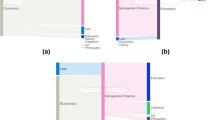Abstract
This study introduces nation diffusion breadth and nation diffusion intensity by adapting the notions of field diffusion breadth and field diffusion intensity as defined by Liu and Rousseau, and a variation on the total cited influence indicator introduced by Hu et al. Knowledge diffusion across countries in the field of management is then analyzed as a case study. Main countries in the field of management studies are considered as centers in their own ego-centered citation networks. The three indicators mentioned above are then calculated for these ego-centered citation networks. They measure the scientific impact each of these countries has on other nations. A general picture of the knowledge diffusion process is given by the three indicators at the country level over four periods 1992–1996, 1997–2001, 2002–2006, and 2007–2011. The validity of the proposed indicators is verified by the calculated results.




Similar content being viewed by others
References
Bar-Ilan, J. (2008). Informetrics at the beginning of the 21st century—A review. Journal of Informetrics, 2, 1–52.
Bettencourt, L. M. A., Cinrón-Arias, A., Kaiser, D. I., & Castillo-Chávez, C. (2006). The power of a good idea: quantitative modeling of the spread of ideas from epidemiological models. Physica A, 364, 513–536.
Bettencourt, L., Kaiser, D., Kaur, J., Castillo-Chávez, C., & Wojick, D. (2008). Population modeling of the emergence and development of scientific fields. Scientometrics, 75(3), 495–518.
Breschi, S., & Lissoni, F. (2004). Knowledge networks from patent data. In H. F. Moed, W. Glänzel, & U. Schmoch (Eds.), Handbook of quantitative science and technology research. Dordrecht: Kluwer.
Chen, C., & Hicks, D. (2004). Tracing knowledge diffusion. Scientometrics, 59(2), 199–211.
De Nooy, W., Mrvar, A., & Batagelj, V. (2005). Exploratory network analysis with Pajek. New York: Cambridge University Press.
Egghe, L. (2005). Journal diffusion factors and their mathematical relations with the number of citations and with the impact factor. In P. Ingwersen & B. Larsen (Eds.), Proceedings of ISSI 2005 (pp. 109–120). Stockholm: Karolinska University Press.
Fleming, L. (2001). Recombinant uncertainty in technological search. Management Science, 47(1), 117–132.
Frandsen, T. F. (2004). Journal diffusion factors: a measure of diffusion? Aslib Proceedings, 56(1), 5–11.
Frandsen, T. F., Rousseau, R., & Rowlands, I. (2006). Diffusion factors. Journal of Documentation, 62(1), 58–72.
Gao, X., & Guan, J. C. (2012). Network model of knowledge diffusion. Scientometrics, 90, 749–762.
Genuis, S. K. (2006). Exploring the role of medical and consumer literature in the diffusion of information related to hormone therapy for menopausal Women. Journal of the American Society for Information Science and Technology, 57(7), 974–988.
Hu, X. J., Rousseau, R., & Chen, J. (2011). On the definition of forward and backward citation generations. Journal of Informetrics, 5, 27–36.
Hu, X. J., Rousseau, R., & Chen, J. (2012). Structural indicators in citation networks. Scientometrics, 91, 451–460.
Hummon, N. P., & Doreian, P. (1989). Connectivity in a citation network: the development of DNA theory. Social Networks, 11, 39–63.
Kiss, I. Z., Broom, M., Craze, P. G., & Rafols, I. (2010). Can epidemic models describe the diffusion of topics across disciplines? Journal of Informetrics, 4, 74–82.
Lambiotte, R., & Panzarasa, P. (2009). Communities, knowledge creation, and information diffusion. Journal of Informetrics, 3, 180–190.
Leydesdorff, L., & Rafols, I. (2009). A global map of science based on the ISI subject categories. Journal of the American Society for Information Science and Technology, 60(2), 348–362.
Liu, X., Kaza, S., Zhang, P. Z., & Chen, H. C. (2011). Determining inventor status and its effect on knowledge diffusion: a study on nanotechnology literature from China, Russia, and India. Journal of the American Society for Information Science and Technology, 62(6), 1166–1176.
Liu, Y. X., & Rousseau, R. (2010). Knowledge diffusion through publications and citations: a case study using ESI-Fields as unit of diffusion. Journal of the American Society for Information Science and Technology, 61(2), 340–351.
Ma, N., Guan, J. C., & Zhao, Y. (2008). Bringing PageRank to the citation analysis. Information Processing and Management, 44, 800–810.
Rogers, E. M. (2003). Diffusion of innovations (5th ed.). New York: Free Press.
Rowlands, I. (2002). Journal diffusion factor: a new approach to measuring research influence. Aslib Proceedings, 54(2), 77–84.
Valente, T. W. (1995). Network models of the diffusion of innovations. Cresskill: Hampton Press.
Wasserman, S., & Faust, K. (1994). Social network analysis. Cambridge: Cambridge University Press.
Zhang, L., Thijs, B., & Glänzel, W. (2011). The diffusion of H-related literature. Journal of Informetrics, 5, 583–593.
Acknowledgments
This study is supported by a grant from National Natural Science Foundation of China (no. 71373254). The authors wish to thank Professor Ronald Rousseau for his great guidance, constructive suggestions and careful English corrections of the article, which significantly improved the quality of the paper.
Author information
Authors and Affiliations
Corresponding author
Additional information
J. Guan and W. Zhu are contributed equally to this paper.
Appendix
Appendix
Rights and permissions
About this article
Cite this article
Guan, J., Zhu, W. How knowledge diffuses across countries: a case study in the field of management. Scientometrics 98, 2129–2144 (2014). https://doi.org/10.1007/s11192-013-1134-1
Received:
Published:
Issue Date:
DOI: https://doi.org/10.1007/s11192-013-1134-1




